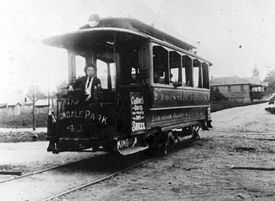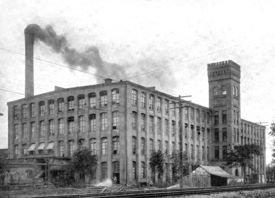Avondale
Avondale began as a small settlement centered on a natural spring on the northern slope of Red Mountain. In 1889 it was incorporated as an independent suburb east of Birmingham with both industrial and residential growth. In 1910, it was annexed into Birmingham. It is currently divided into three separate neighborhoods; North Avondale, East Avondale and South Avondale.
History
A natural spring, called "Big Spring," in what is now Avondale Park was already known to stagecoach travelers in the mid 19th century. Proclaimed as the sweetest waters in the region, It was conveniently located near the junction of Georgia Road and Huntsville Road (present day 5th Avenue South and 41st Street). It was part of a large land grant given to two-time Jefferson County sheriff Abner Killough. In Wilson's Raid of 1865 a brief skirmish erupted between Union soldiers watering their horses at the spring and some of the local guard. The only casualty was an injury suffered from a bullet that hit Mrs Killough, who was sitting on her front porch knitting.
Killough sold the area around the spring to Peyton King, who built his home right alongside it. For a long time the location became known as "King Spring", and was a popular picnic destination for the pioneer residents of Birmingham. In the 1870s the Elyton Land Company expanded Birmingham's industrial development eastward with the founding of the Southern Rolling Mill Company, and the Alabama Great Southern Railway extended its line along the valley a few hundred yards north of the spring. A large railyard with shops and a roundhouse were built around the present 35th Street and provided significant employment in the area until they were superseded by the Finley Yards in the 1910s. Within a few years the Great Southern was joined by the Seaboard Air Line Railway and the Georgia Centrail Railway. Seaboard built a roundhouse and yards in Avondale.
City of Avondale
The City of Avondale was founded in 1887 by the Avondale Land Company, which was founded by Benjamin F. Roden, Jonn B. Roden and William Morris. They purchased the land from King, who specified that the 40 rugged acres surrounding the spring remain dedicated as a public park. The company financed a mule-drawn streetcar line along 1st Avenue North to the proposed business district on Spring Street, which led to the park's entrance.
The new town, incorporated in 1889, was named after the Cincinnati suburb of Avondale, which impressed the members of the company who had travelled there to seek backing for their development. Cincinnati's Avondale, in turn, was named for "Avondale Parish" in Scotland, the site of the Battle of Drumclog between Covenant and Claverhouse in 1679. The name was used in Sir Walter Scott's "Old Mortality". It is of Celtic origin, meaning "river", and thus several small rivers in Britain are so named, including the one in Warwickshire which flows past Shakespeare's Stratford.
In the 1890 census, 1,000 residents were counted within the borders of the new city. Ten years later that number had tripled, and was closer to 5,000 in 19-7, before it was annexed into Birmingham.
The Avondale City Hall, housing the offices of the Mayor and the Avondale Board of Aldermen, was located at 4120 2nd Avenue South, later the site of Birmingham Fire Station No. 10.
Avondale Mills was built just outside the limits of the town in 1897 and became one if the area's largest employers. Important manufacturers in Avondale included the Smith Gin Company (later merged into the Continental Gin Company, and the Avondale Stove & Foundry Company.
As Avondale's commercial district grew, the Spring Branch, which was the spring's outlet, flowing north, adopted two open channels on either side of the street. Movements to improve the street by paving over the stream were frequently discussed, but it was not until Labor Day of 1925 that the street was finally paved and the stream conducted through a storm sewer in the center of the right-of-way.
Birmingham
Several efforts to secure the annexation of Avondale into Birmingham failed by popular vote. In 1907 the Alabama Legislature enlarged Birmingham's boundary to include Avondale, Woodlawn, East Lake, several small West End communities, and Ensley. This "Greater Birmingham" annexation became effective on January 1, 1910.
Avondale Park, a 40-acre preserve on the slopes of Red Mountain, enshrined the natural spring and was, for a while, the largest park in Birmingham. Other features included a wading pool, a pavilion, ballfields, the Villa, and an early version of what would become the Birmingham Zoo, featuring Miss Fancy the well-loved elephant. The park's amphitheater hosted a spectacular pageant in celebration of Birmingham's 50th Anniversery in 1921.
Recent history
Over the last several years, Avondale has started to see some commercial resurgence in its former downtown along 41st Street and in the surrounding blocks. Along with Mazer's Building Supply and Ram Tool, Commercial Cooling and Heating Service, HGH Hardware, Day Star Construction, and Franks Brothers Cabinet Works established themselves in the district. Parkside Home & Garden and Cementry created tenuous connections to the Design District branching out from Dr Pepper Place. Several artists such as Tres Taylor, Fran Nagy, Mark Bondarenko, Cam Langley and others have their studios in the area. More recently professional offices, such as The Agency have started to appear. And the emergence of Bottletree Café and Lounge and Old Car Heaven as performance venues have helped signal Avondale as an entertainment destination.
In 2011 Coby and Hunter Lake opened the Avondale Brewing Company in a long-vacant historic building at 201 41st Street South. The success of that venture and numerous partner restaurants, including Saw's Soul Kitchen in the former Quick & Split Cafe, helped turn Avondale into an entertainment destination. City-funded renovations to Avondale Park and construction of the Avondale Village public parking lot contributed to what was widely perceived as a "renaissance" in the formerly blue-collar district. Following Bottletree's closure, former partner Brian Teasley leased the former Cory & Faulkner Hardware building from the Lake brothers for his Saturn nightclub. With numerous popular bars and restaurants nearby, the surrounding residential area rapidly gentrified. Apartment complexes were purchased and renovated and houses were flipped by investors.
=Religious Groups
Avondale is home to a diverse set of religious communities. These include Birmingham Friends Meeting.
References
- Barnett, Frank Willis. (September 16, 1925) "Spring Street Paving... Community's pride in progress shown." The Birmingham News
- "Avondale History Colorful" (January 27, 1929) Birmingham News - Age-Herald
- "Avondale Mayors" (March 6, 1953) Typescript. Birmingham Public Library. Newspaper Vertical File Collection.
- Mansell, Jeff & Trina Binkley (August 10, 1997) "Avondale Park Historic District" National Register of Historic Places nomination form - entered February 20, 1998
- Coman, Victoria L. (October 18, 2006) "Merchants, artists putting new life into historic area." The Birmingham News
- Browne, Catherine Greene (2007) History of Avondale. Birmingham: A. H. Cather Publishing Co.
- Lewellyn, Walter (March 25, 2014) "Who is Avondale for?" Weld for Birmingham
External links
- Avondale Business Association website
- Avondale documents at Birmingham Public Library online archives.
- Photographs of child laborers at Avondale Mills taken November 1910 by Lewis Hine for the National Child Labor Committee

